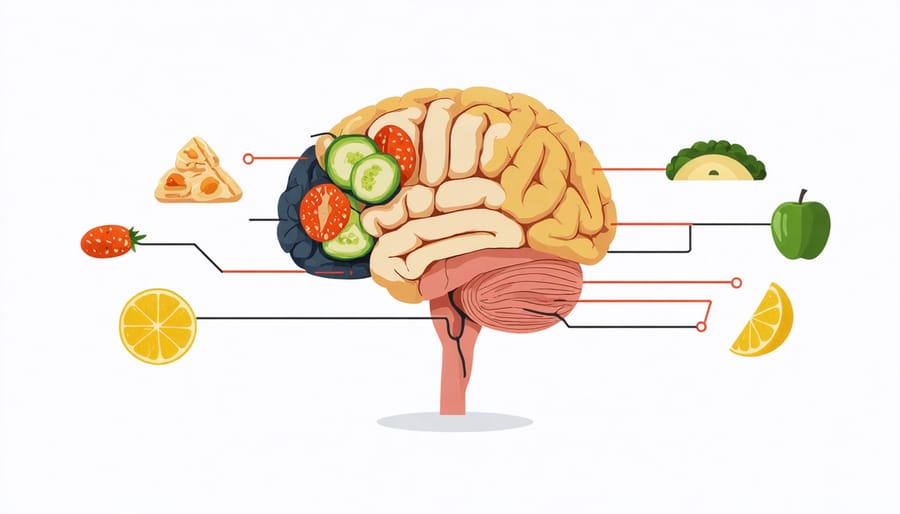The food choices we make shape not just our physical health, but profoundly influence our behavior, mood, and cognitive function. Behavioral nutrition explores this powerful connection between what we eat and how we think, feel, and act – particularly during critical developmental stages of childhood. Recent research reveals that up to 90% of serotonin, our “feel-good” neurotransmitter, is produced in the gut, highlighting the intimate relationship between diet and mental wellbeing.
For parents and educators navigating children’s nutritional needs, understanding this connection opens new possibilities for supporting emotional regulation, focus, and positive behavior through dietary choices. From reducing anxiety with omega-3 rich foods to improving attention spans through balanced blood sugar levels, the science of behavioral nutrition offers evidence-based strategies for nurturing both body and mind.
This emerging field bridges the gap between traditional nutrition science and behavioral psychology, providing practical insights for anyone seeking to optimize mental health and behavior through dietary intervention. Whether dealing with attention challenges, mood swings, or general behavioral concerns, behavioral nutrition offers a natural, holistic approach to supporting children’s developmental success.
Understanding Behavioral Nutrition in Child Development
What is Behavioral Nutrition?
Behavioral nutrition is an approach that examines the relationship between what we eat and how we behave, focusing on the psychological and social factors that influence our food choices and eating patterns. This field combines principles from nutrition science with behavioral psychology to understand why we make certain food choices and how these decisions impact our mental and physical well-being.
Think of behavioral nutrition as a bridge connecting our eating habits with our daily actions and emotions. For example, when a child feels stressed, they might reach for sugary snacks, or when they’re happy, they might be more open to trying new, healthy foods. Understanding these connections helps parents and caregivers create positive eating environments and develop healthy relationships with food.
The approach looks at various factors that shape our eating behaviors, including:
– Family meal traditions and cultural influences
– Emotional connections to certain foods
– Environmental triggers for eating
– Social pressures and peer influence
– Personal food preferences and experiences
By understanding these elements, we can better support children in developing healthy eating habits that contribute to their overall well-being and development.
The Brain-Gut Connection
Have you ever noticed how your child’s mood changes after certain meals? This isn’t just coincidence – it’s part of the fascinating mind-body connection that scientists are increasingly understanding. The gut and brain communicate constantly through what’s called the gut-brain axis, significantly influencing behavior, emotions, and cognitive function.
When children eat nutritious foods, their gut produces beneficial chemicals called neurotransmitters, including serotonin – often called the “happy hormone.” In fact, about 90% of serotonin is produced in the gut, not the brain! This explains why a balanced diet can help maintain stable moods and better focus.
Dr. Sarah Thompson, a pediatric nutritionist, explains: “What we feed our children doesn’t just fuel their bodies – it shapes their brain chemistry and affects how they feel, think, and behave throughout the day.”
Poor dietary choices can trigger inflammation in the gut, which may lead to mood swings, difficulty concentrating, and behavioral challenges. Conversely, a diet rich in whole foods, fruits, vegetables, and healthy fats supports optimal brain function and emotional well-being.


Key Nutrients That Impact Child Mental Health
Omega-3 Fatty Acids and Brain Development
Omega-3 fatty acids play a crucial role in your child’s brain development and emotional well-being. These essential nutrients, found in foods like fatty fish, walnuts, and flaxseeds, help build and maintain the brain’s structure while supporting cognitive function and emotional regulation techniques.
Dr. Sarah Chen, a pediatric nutritionist, explains, “Think of omega-3s as building blocks for your child’s brain. They’re particularly important during the early years when the brain is developing rapidly, but they continue to be essential throughout childhood and adolescence.”
Research shows that children who consume adequate amounts of omega-3s often display better focus, improved memory, and more stable moods. For example, eight-year-old Tommy’s parents noticed significant improvements in his concentration after incorporating omega-3-rich foods into his daily meals.
To boost your child’s omega-3 intake, try serving salmon twice a week, adding ground flaxseeds to smoothies, or offering chia seed pudding as a snack. If your child is a picky eater, consult with your healthcare provider about appropriate supplements to ensure they’re getting enough of these brain-boosting nutrients.
The Role of B Vitamins
B vitamins play a crucial role in supporting healthy brain function and emotional well-being. As Sarah Thompson, a pediatric nutritionist with over 15 years of experience, explains, “These essential nutrients are like the building blocks for our children’s mental health.”
The B vitamin family, particularly B6, B12, and folate, helps produce neurotransmitters that regulate mood, attention, and behavior. When children don’t get enough of these vitamins, they may experience irritability, difficulty concentrating, and changes in their emotional responses.
Foods rich in B vitamins include whole grains, eggs, leafy greens, and lean meats. For example, eight-year-old Tommy showed significant improvements in his focus and mood after his parents incorporated more B vitamin-rich foods into his daily meals.
While a balanced diet should provide adequate B vitamins, some children might need additional support. Dr. Lisa Chen, a child development specialist, suggests consulting with healthcare providers before starting any supplementation: “Every child is unique, and their nutritional needs vary. It’s important to create an individualized approach that works for your child.”
Remember that consistent, long-term nutrition habits have the most impact on behavioral health, rather than quick fixes or temporary changes.
Minerals and Mood Regulation
Just as our bodies need minerals for physical health, these essential nutrients also play a crucial role in regulating our mood and behavior. Three minerals, in particular, stand out for their impact on mental well-being: zinc, iron, and magnesium.
Zinc helps our bodies process neurotransmitters that affect mood and behavior. Children with adequate zinc levels often show better focus and emotional regulation. As one parent shared, “After working with our pediatrician to address my son’s zinc deficiency, we noticed significant improvements in his mood and concentration.”
Iron deficiency, common in growing children, can lead to irritability and difficulty concentrating. Dr. Sarah Martinez, a pediatric nutritionist, explains, “When children don’t get enough iron, their brain doesn’t receive the oxygen it needs to function optimally, which can affect their behavior and learning ability.”
Magnesium, often called the “calming mineral,” helps regulate stress responses and promotes better sleep. Many children today consume less magnesium than recommended, which may contribute to increased anxiety and restlessness.
Good sources of these minerals include:
– Zinc: lean meats, nuts, and whole grains
– Iron: leafy greens, fortified cereals, and lean red meat
– Magnesium: bananas, yogurt, and dark chocolate
Remember to consult with your healthcare provider before starting any supplementation, as they can test for deficiencies and recommend appropriate dosages for your child’s specific needs.
Creating Positive Food Behaviors
Family Meal Routines
Regular family meals are more than just a time to eat – they’re powerful opportunities to establish healthy eating habits and strengthen family bonds. Research shows that children who regularly share meals with their families tend to have better nutrition, improved social skills, and higher academic performance.
Creating consistent meal routines helps children feel secure and develops healthy relationships with food. When families eat together at predictable times, children learn to recognize their hunger and fullness cues naturally. Dr. Sarah Martinez, a pediatric nutritionist, notes, “Structured mealtimes help children develop better self-regulation around food and create lasting positive associations with eating.”
Try to make family meals a priority at least 3-4 times per week. Turn off screens, sit together at the table, and engage in conversation. This doesn’t mean every meal needs to be perfect – even a simple breakfast together counts! Keep the atmosphere positive and avoid pressuring children to eat specific foods or amounts.
Remember that children learn by example. When they see parents and siblings enjoying varied, nutritious foods in a relaxed setting, they’re more likely to develop similar habits. Make mealtimes enjoyable by sharing stories about your day, playing simple word games, or involving children in meal preparation when possible. These shared experiences create lasting memories while fostering healthy eating behaviors that can benefit children throughout their lives.

Mindful Eating Practices
Teaching children mindful eating habits early in life can foster a healthy relationship with food that lasts into adulthood. Start by creating a calm, distraction-free environment during mealtimes – this means turning off screens and sitting together as a family whenever possible. Encourage children to listen to their body’s hunger and fullness cues, helping them recognize when they’re genuinely hungry versus eating out of boredom or emotion.
Make mealtimes an opportunity for connection and learning. Talk about different food colors, textures, and flavors. Ask your child to describe how their food tastes and feels, promoting awareness of the eating experience. This not only develops their vocabulary but also helps them stay present during meals.
Practice the “pause and notice” technique – teach children to take a moment before eating to observe their food, smell it, and appreciate where it came from. This simple practice can help develop gratitude for food and those who prepared it.
Remember that children learn by example. When parents model mindful eating behaviors, such as eating slowly and expressing enjoyment of healthy foods, children are more likely to adopt these habits themselves. Keep conversations about food positive and avoid using food as a reward or punishment, as this can create unhealthy associations that may persist into later life.
Managing Picky Eating
Picky eating is a common challenge that many parents face, and it’s important to approach it with patience and understanding. Dr. Sarah Chen, a pediatric nutritionist, often reminds parents that selective eating can be a normal part of child development. “The key is to create positive associations with food while maintaining consistent boundaries,” she explains.
Start by establishing regular meal times and creating a calm, pleasant eating environment. Avoid turning mealtimes into power struggles or using food as a reward or punishment. Instead, offer a variety of healthy choices and let your child have some control over what and how much they eat from these options.
Consider the “division of responsibility” approach: parents decide what foods to offer, when, and where, while children decide whether and how much to eat. This method helps reduce mealtime tension and supports healthy eating habits.
Try these practical strategies:
– Involve children in meal planning and preparation
– Offer new foods alongside familiar favorites
– Model healthy eating behaviors
– Praise trying new foods, even tiny tastes
– Serve small portions to avoid overwhelming children
– Be patient – it can take 10-15 exposures for a child to accept a new food
Remember that extreme picky eating might sometimes indicate underlying sensory issues or anxiety. If you’re concerned about your child’s eating patterns, consult with their healthcare provider for personalized guidance.
When to Seek Professional Help
While dietary changes can significantly impact behavior and mental health, there are times when professional help becomes essential. If you notice persistent challenging behaviors, severe mood swings, or significant changes in eating patterns that don’t improve with basic interventions, it’s time to consult a specialist.
Key warning signs include:
– Extreme food selectivity or restriction
– Dramatic weight changes
– Ongoing aggressive or disruptive behavior
– Persistent anxiety around meals
– Physical symptoms like fatigue or digestive issues
– Social withdrawal during mealtimes
– Sleep disturbances related to eating patterns
Don’t hesitate to reach out to healthcare providers if these issues persist for more than a few weeks. A qualified professional can conduct proper assessments and develop targeted intervention strategies. Remember, seeking help early often leads to better outcomes.
Available resources include:
– Registered dietitians specializing in behavioral nutrition
– Child psychologists
– Occupational therapists
– Pediatric mental health specialists
– Support groups for families
Your child’s pediatrician can provide referrals to appropriate specialists and guide you toward effective mental health support. Many schools also offer access to nutrition counselors and behavioral specialists who can help address concerns in the educational setting.
Remember, seeking professional help isn’t a sign of failure – it’s a proactive step toward supporting your child’s well-being. Many families face similar challenges, and there’s no shame in asking for expert guidance when needed.
Understanding the connection between nutrition and behavior empowers us to make positive changes in our children’s lives. By recognizing that food choices directly impact mood, attention, and overall mental well-being, we can take meaningful steps toward supporting our children’s health through diet.
Remember that small changes can make a big difference. Start by incorporating more whole foods, reducing processed sugars, and ensuring regular meal times. Pay attention to your child’s individual responses to different foods, and work with healthcare providers to address any specific dietary needs or concerns.
Creating healthy eating habits is a journey, not a destination. Be patient with yourself and your children as you implement changes. Focus on progress rather than perfection, and celebrate small victories along the way. By modeling good nutrition choices and maintaining a positive attitude about food, we help our children develop a healthy relationship with eating that can last a lifetime.
Together, we can nurture our children’s bodies and minds through thoughtful nutrition choices, setting them up for success in school, relationships, and life.


